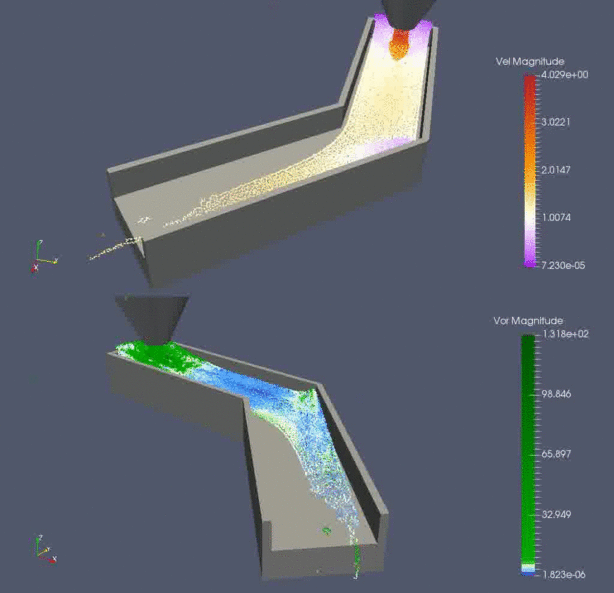Smoothed Particle Hydrodynamics
Exploring the method of smoothed particle hydrodynamics (SPH) and its application to iceberg capsize dynamics
Lynn Kaluzienski, 9/20/2015, University of Maine
Analytical solutions for problems in fluid dynamics are unavailable for most real world flows. The method of Smoothed Particle Hydrodynamics (SPH) was initially developed for astrophysical problems and has since been used to formulate approximate solutions for equations in fluid dynamics, chiefly the Navier Stokes solution for a weakly compressible fluid. SPH takes the innovative approach of replacing a fluid with an array of particles and solving the Navier Stokes equation on a particle by particle basis. A smoothing function is applied to each individual particle to determine the influence of its neighbors within a certain radius giving more weight to nearby particles. SPH is naturally a meshfree Lagrangian method, providing several benefits over former gridbased techniques in capturing surface accelerations and removing the need of tracking fluid boundaries. One difficulty with the SPH method is the need for a large quantity of particles to achieve the same precision as a gridbased approach. However, recent improvements in computational power such as the widespread use of graphic processing units (GPUs) have made SPH implementation feasible and computationally inexpensive. Several open source codes, such as DualSPHysics, make high resolution SPH simulations easily achievable on computers with multiple GPU processing units. Depending on complexity, several hundred thousand particle simulations can be achieved on the order of minutes to hours on a desktop computer. Largerscale models with millions to even billions of particles can be efficiently computed on supercomputers. The University of Maine SECS Numerical Laboratory currently has SPH simulations running on multiple GPUs. In addition, our collaboration with the Advanced Computing Group at Umaine will allow us to run increasingly complex and higher resolution simulations on one of their supercomputers in the near future.
Supporting Literature: Crespo et al 2015, Monaghan 2012
| In this model a fluid is initially held in a square configuration along a sloped ramp with open boundaries on both sides. At the the first time step the fluid is allow to flow outward due to the force of gravity and begins to flow down the ramp. Once the fluid particles meet the boundary edge on the right they cross over to the left side of the ramp. During the first few time steps the fluid quickly moves to fill the void on the upper left hand side and crashes with slower moving particles creating a significant splashing effect and the formation of a standing wave. Throughout the simulation this standing wave begins to die out as the flow approaches a state of equilibrium.
Credits: DualSPHysics |
|---|
Investigating sediment mobilization in dammed fluvial systems using smoothed particle hydrodynamics (SPH)
Nick Richmond, 4/18/2016, University of Maine
When dams are removed, altered upstream and downstream fluvial dynamics give rise to sediment mobilization, which disrupts critical zone processes. Most methods used to model fluvial hydrodynamics are restricted to one or two dimensions, which limits description of small-scale motion and nuanced flow regimes that contribute to sediment advection. Smoothed particle hydrodynamics (SPH) provides solutions to the Navier-Stokes equations and allows interactions between weakly-compressible fluids and solid structures to be resolved in three-dimensional space. By adapting smoothed particle hydrodynamics simulations to fluvial systems, the sediment mobilization potential associated with dam removal can be investigated for dammed fluvial systems in Maine’s Penobscot River. By rendering synthetic features such as vegetated banks, scalloped riverbeds, aits, and dams, it becomes possible to describe the contributions of these features to the Penobscot River's hydrodynamics. Incorporating sediment advection, periodic boundary conditions, and buoyant incompressible solids into the SPH framework provides detailed solutions which will be used to simulate the acute impacts of dam removal on the Penobscot River’s hydrodynamics and biological habitats.
| Click on the animated gif for the full video!
<description pending.> |

|
|---|
For DualSPHysics users operating in the UMaine SECS Numerical Modeling Laboratory:
Please see the DualSPHysics User Guide for a basic program tutorial.